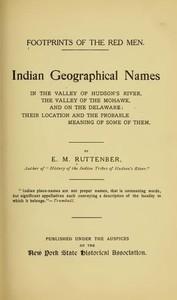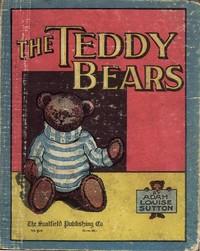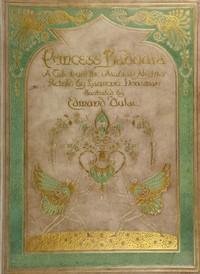Read this ebook for free! No credit card needed, absolutely nothing to pay.
Words: 111333 in 21 pages
This is an ebook sharing website. You can read the uploaded ebooks for free here. No credit cards needed, nothing to pay. If you want to own a digital copy of the ebook, or want to read offline with your favorite ebook-reader, then you can choose to buy and download the ebook.


: Footprints of the Red Men Indian geographical names in the valley of Hudson's river the valley of the Mohawk and on the Delaware: their location and the probable meaning of some of them. by Ruttenber Edward Manning - Names Indian North America; Indians of
FOOTPRINTS OF THE RED MEN.
Indian Geographical Names
IN THE VALLEY OF HUDSON'S RIVER, THE VALLEY OF THE MOHAWK, AND ON THE DELAWARE: THEIR LOCATION AND THE PROBABLE MEANING OF SOME OF THEM.
PUBLISHED UNDER THE AUSPICES OF THE New York State Historical Association.
Copyrighted by the
NEW YORK STATE HISTORICAL ASSOCIATION. 1906.
Primary Explanations.
The locatives of the Indian geographical names which have been handed down as the names of boundmarks or of places or tribes, are properly a subject of study on the part of all who would be familiar with the aboriginal geography of a district or a state. In many cases these names were quite as designative of geographical centers as are the names of the towns, villages and cities which have been substituted for them. In some cases they have been wisely retained, while the specific places to which they belonged have been lost. In this work special effort has been made, first, to ascertain the places to which the names belonged as given in official records, to ascertain the physical features of those places, and carry back the thought to the poetic period of our territorial history, "when the original drapery in which nature was enveloped under the dominion of the laws of vegetation, spread out in one vast, continuous interminable forest," broken here and there by the opened patches of corn-lands and the wigwams and villages of the redmen; secondly, to ascertain the meanings of the aboriginal names, recognizing fully that, as Dr. Trumbull wrote, "They were not proper names or mere unmeaning marks, but significant appellatives conveying a description of the locatives to which they were given." Coming down to us in the crude orthographies of traders and unlettered men, they are not readily recognized in the orthographies of the educated missionaries, and especially are they disguised by the varying powers of the German, the French, and the English alphabets in which they were written by educated as well as by uneducated scribes, and by traders who were certainly not very familiar with the science of representing spoken sounds by letters. In one instance the same name appears in forty-nine forms by different writers. Many names, however, have been recognized under missionary standards and their meanings satisfactorily ascertained, aided by the features of the localities to which they were applied; the latter, indeed, contributing very largely to their interpretation. Probably the reader will find geographical descriptions that do not apply to the places where the name is now met. The early settlers made many transfers as well as extensions of names from a specific place to a large district of country. It must be remembered that original applications were specific to the places which they described even though they were generic and applicable to any place where the same features were referred to. The locatives in Indian deeds and original patents are the only guide to places of original application, coupled with descriptive features where they are known.
No vocabularies of the dialects spoken in the lower valley of the Hudson having been preserved, the vocabularies of the Upper-Unami and the Minsi-Lenape, or Delaware tongues on the south and west, and the Natick, or Massachusetts, on the north and east, have been consulted for explanations by comparative inductive methods, and also orthographies in other places, the interpretations of which have been established by competent linguists. In all cases where the meaning of terms has been particularly questioned, the best expert authority has been consulted. While positive accuracy is not asserted in any case, it is believed that in most cases the interpretations which have been given may be accepted as substantially correct. There is no poetry in them--no "glittering waterfalls," no "beautiful rivers," no "smile of the Great Spirit," no "Holy place of sacred feasts and dances," but plain terms that have their equivalents in our own language for a small hill, a high hill, a mountain, a brook, a creek, a kill, a river, a pond, a lake, a swamp, a large stone, a place of small stones, a split rock, a meadow, or whatever the objective feature may have been as recognized by the Indian. Many of them were particular names in the form of verbals indicating a place where the action of the verb was performed; occasionally the name of a sachem is given as that of his place of residence or the stream on which he resided, but all are from generic roots.
A considerable number of record names have been included that are not living. They serve to illustrate the dialect spoken in the valley as handed down by European scribes of different languages, as well as the local geography of the Indians. The earlier forms are mainly Dutch notations. A few Dutch names that are regarded by some as Indian, have been noticed, and also some Indian names on the Delaware River which, from the associations of that river with the history of the State, as in part one of its boundary streams, as well as the intimate associations of the names with the history of the valley of Hudson's River, become of especial interest.
In the arrangement of names geographical association has been adopted in preference to the alphabetical, the latter being supplied by index. This arrangement seems to bring together dialectic groups more satisfactorily. That there were many variations in the dialects spoken in the valley of Hudson's River no one will deny, but it may be asserted with confidence that the difference between the German and the English alphabets in renderings is more marked than differences in dialects. In so far as the names have been brought together they form the only key to the dialects which were spoken in the valley. Their grammatical treatment is the work of skilled philologists.
Free books android app tbrJar TBR JAR Read Free books online gutenberg
More posts by @FreeBooks








